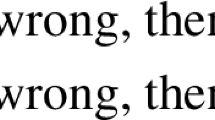Conclusion
The restricted semantic ellipsis hypothesis, we have argued, is committed to an enormous number of multiply ambiguous expressions, the introduction of which gains us no extra explanatory power. We should, therefore, reject it. We should also spurn the original version since: (a) it entails the restricted version and (b) it incorrectly declares that, whenever a speaker makes an assertion by uttering an unembedded word or phrase, the expression uttered has illocutionary force.
Once rejected, the semantic ellipsis hypothesis cannot account for the many exceptions to the syntactic ellipsis hypothesis. So, we can safely infer that the Claim is true.
(1)The Claim: Speakers can make assertions by uttering ordinary, unembedded, words and phrases.
To the degree that the Claim reallyis in tension with the primacy of sentences (i.e., the view that (a) only sentences can be used to make assertions and (b) only sentences are meaningful in isolation) this doctrine must also be rejected.
Similar content being viewed by others
References
Bach, E.: 1989,Informal Lectures on Formal Semantics, State University of New York Press, Albany, New York.
Barton, E.: 1990,Nonsentential Constituents, John Benjamins, Philadelphia, Pennsylvania.
Barton, E.: 1989, ‘Nonsentential Constituents and Theories of Phrase Structure’, paper delivered to the Views on Phrase Structure Conference, University of Florida. Subsequently published (1991) in K. Leffel and D. Bouchard (eds.),Views on Phrase Structure, Kluwer, Dordrecht.
Brame, M. K.: 1979, ‘A Note on COMP S Grammar vs. Sentence Grammar’,Linguistic Analysis 5, 383–386.
Chierchia, G. and S. McConnell-Ginet: 1990,Meaning and Grammar. An Introduction to Semantics, MIT Press, Cambridge, Massachusetts.
Chomsky, N.: 1986a,Barriers, MIT Press, Cambridge, Massachusetts.
Chomsky, N.: 1986b,Knowledge of Language: Its Nature, Origin and Use, Praeger, New York.
Chomsky, N.: 1982,Some Concepts and Consequences of the Theory of Government and Binding, The MIT Press, Cambridge, Massachusetts.
Chomsky, N.: 1981,Lectures on Government and Binding, Foris Publications, Dordrecht.
Dalrymple, M.: 1991, ‘Against Reconstruction in Ellipsis’. CSLI manuscript, Stanford University, Stanford California.
Davidson, D.: 1967, ‘Truth and Meaning’, reprinted (1984) inInquiries into Truth and Interpretation, Clarendon Press, Oxford.
Dowty, D., R. E. Wall and S. Peters: 1981,Introduction to Montague Semantics, D. Reidel, Dordrecht.
Dummett, M.: 1981,The Interpretation of Frege's Philosophy, Duckworth, London.
Dummett, M.: 1973,Frege: Philosophy of Language, Duckworth, London.
Evans, G.: 1982,The Varieties of Reference, edited by J. McDowell, Clarendon Press, Oxford.
Frege, G.: 1978,Foundations of Arithmetic, translated by J. L. Austin. 2nd revised edition, Basil Blackwell, Oxford.
Hacking, I.: 1975,Why does Language Matter to Philosophy? Cambridge University Press, Cambridge.
Haegeman, L.: 1991, Introduction to Government and Binding Theory. Oxford: Blackwell.
Jackendoff, R. S.: 1977,X-bar Syntax: A Study of Phrase Structure, Cambridge, MIT Press, Massachusetts.
Kaplan, D.: 1977, ‘Demonstratives’, in J. Almog, J. Perry and H. Wettstein (eds.),Themes from Kaplan, 1989, Oxford University Press, Oxford.
Katz, J. J.: 1980,Propositional Structure and Illocutionary Force: A Study of the Contribution of Sentence Meaning to Speech Acts, Harvard University Press, Cambridge, Massachusetts.
Lewis, D.: 1970, ‘General Semantics’, reprinted (1983) inPhilosophical Papers, Vol. I, Oxford University Press, Oxford.
Morgan, J. L.: 1989, ‘Sentence Fragments Revisited’,Chicago Linguistics Society: Papers from the parasession on language in context 25, 228–241.
Morgan, J. L.: 1973, ‘Sentence Fragments and the Notion of “Sentence”’, in B. B. Kachru et al. (eds.),Issues in Linguistics. Papers in Honor of Henry and Renée Kahane, University of Illinois Press, Urbana, Illinois.
Napoli, D. J.: 1982, ‘Initial Material Deletion in English’,Glossa 16, 85–111.
Quirk, R. et al.: 1985,A Comprehensive Grammar of the English Language, Longmans, London.
Sperber, D. and D. Wilson: 1986,Relevance: Communication and Cognition, Harvard University Press, Cambridge, Massachusetts.
Stainton, R. J.: (in preparation), ‘Remarks on Syntactic Ellipsis’, manuscript, Carleton University, Ottawa, Canada.
Stainton, R. J.: 1994, ‘Using Non-Sentences: An Application of Relevance Theory’,Pragmatics & Cognition 2, 269–284.
Stainton, R. J.: 1993,Non-Sentential Assertions, unpublished Doctoral Dissertation, MIT, Cambridge, Massachusetts.
Stalnaker, R.: 1978, ‘Assertion’, in P. Cole (ed.),Syntax and Semantics, Vol. 9, Academic Press, New York.
Yanofsky, N.: 1978, ‘NP utterances’,Chicago Linguistics Society: Papers from the Regional Meeting 14, 491–502.
Rights and permissions
About this article
Cite this article
Stainton, R.J. Non-sentential assertions and semantic ellipsis. Linguist Philos 18, 281–296 (1995). https://doi.org/10.1007/BF00985446
Issue Date:
DOI: https://doi.org/10.1007/BF00985446




